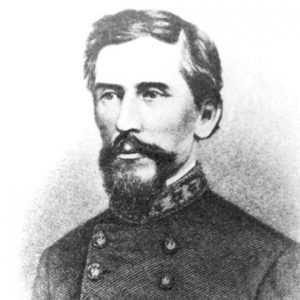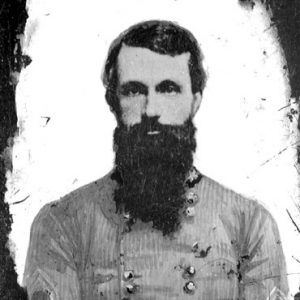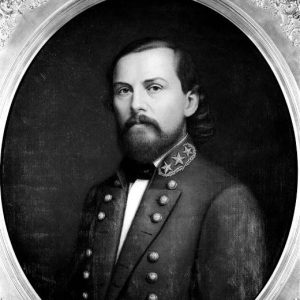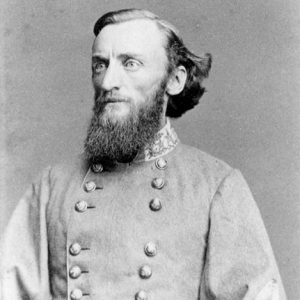calsfoundation@cals.org
Third Confederate Infantry (CS)
The Third Confederate Infantry was a Confederate unit that served in the Western Theater during the American Civil War. The unit of seven companies was primarily made up of men from Greene, Jefferson, Mississippi, Pulaski, St. Francis, and Searcy counties. One Searcy County company was former Arkansas Peace Society men who had been arrested and offered the choice of enlistment or jail. These companies, originally part of Hindman’s Legion, were organized into the First Arkansas Infantry Battalion when Confederate authorities refused to accept the twenty-two-company legion. With the addition of three companies from Tennessee and Mississippi, it officially became the Eighteenth Arkansas Infantry with John S. Marmaduke as colonel, J. B. Johnson as lieutenant colonel, and H. V. Keep as major. On January 1, 1862, it was re-designated the Third Confederate Infantry due to its makeup of soldiers from multiple states, retaining its original field and staff.
After initially participating in the Kentucky Campaign of 1861–1862, the Third Confederate Infantry participated in the Battle of Shiloh on April 6–7, 1862. Here, they led the advance of Thomas Hindman’s brigade and captured the first prisoners of the day. Incurring heavy casualties, the regiment numbered only 239 men at the end of April 1862. In May, it participated in activities around Corinth, Mississippi, and that summer took part in Braxton Bragg’s invasion of central Kentucky, where it fought at the Battle of Perryville on October 8, 1862.
The Third Confederate transferred to Brigadier General Sam Wood’s brigade of Major General Patrick Cleburne’s division and experienced heavy fighting at the battle of Murfreesboro, Tennessee. After routing no less than three lines of enemy infantry throughout the day on December 31, 1862, the regiment again engaged the enemy on January 1, 1863, where it was pinned down under heavy fire. Upon being ordered to retreat, thirty-seven men refused to run the gauntlet and were captured. During the battle, the regiment incurred five killed, twenty-seven wounded, and thirty-seven captured.
Due to heavy casualties, the Third Confederate was consolidated with the Fifth Confederate Infantry under its commander Colonel James A. Smith from March 1863 to April 1864. On September 19–20, 1863, the combined regiments fought in the Battle of Chickamauga in Georgia, where they faced a determined enemy and incurred heavy casualties. This was followed by the battles of Missionary Ridge, Lookout Mountain, and Ringgold, Georgia, during the Confederate retreat in November and December 1863.
In May 1864, the Third Confederate was placed in the Arkansas brigade of Brigadier General Daniel Govan, participating in all the major battles of the Atlanta Campaign. The regiment engaged the enemy at Rocky Face Ridge on May 7, followed by Dalton, Resaca, New Hope Church, Pickett’s Mill, Kennesaw Mountain, Peach Tree Creek, Atlanta, Ezra Church, and Jonesboro. The campaign left the Third Confederate with only fifty-three men present for duty. After the fall of Atlanta on September 1, the Confederate army retreated into northwestern Georgia, reorganized, and rested in preparation for the 1864 invasion of Tennessee.
As winter approached, the unit marched north with John B. Hood’s Army of Tennessee on the ill-fated Franklin-Nashville Campaign. Numbering only forty-seven men, the Third Confederate engaged the enemy at Springhill, Tennessee, on November 29, 1864, and the next day found itself facing an entrenched enemy along the Harpeth River at Franklin, Tennessee. As part of Govan’s brigade of Cleburne’s division, the men made the twilight charge with their comrades, penetrating the works of the enemy. As darkness fell, over 6,000 men and six generals became casualties of the carnage, including fourteen men of the Third Confederate. Arriving in front of the Union army along the Cumberland River, the Third participated in the frigid two-day Battle of Nashville on December 15–16, where Hood’s forces were soundly defeated, and began the precipitous retreat into Alabama.
In the spring, the entire Army of Tennessee moved to North Carolina in an attempt to prevent William Tecumseh Sherman’s army from combining with Ulysses S. Grant’s in Virginia. The Third Confederate fought the last major battle of the war at Bentonville, North Carolina, on March 19–21, 1865. On April 9, all the depleted Arkansas regiments were combined into the First Arkansas Infantry Regiment Consolidated, which was included in the surrender and parole at Greensboro, North Carolina, on April 26, 1865.
For additional information:
Connelly, Thomas L., and James Lee McDonough. Five Tragic Hours: The Battle of Franklin. Knoxville: University of Tennessee Press, 1983.
Daniel, Larry J. Shiloh: The Battle that Changed the Civil War. New York: Simon & Schuster, 1998.
McDonough, James Lee. Stones River: Bloody Winter in Tennessee. Knoxville: University of Tennessee Press, 1983.
The War of the Rebellion: A Compilation of the Official Records of the Union and Confederate Armies. Washington DC: Government Printing Office, 1880–1901.
Anthony Rushing
Benton, Arkansas











Comments
No comments on this entry yet.